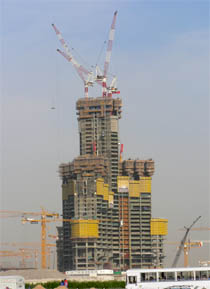
The planned tallest building in the world in Dubai already has 100 floors
 |
Burj Dubai is part of a vast $20 billion project that includes several other shorter skyscrapers set between winding waterways and a massive shopping mall. The skyscraper will also house a six-star Armani Hotel designed by renowned Italian fashion designer Giorgio Armani, and there will also be private apartments and offices in the building.
"The tower is a symbol of Dubai's pride and proof of its inclusion among world-class cities," stated Muhammad Ali Alabbar, chairman of the Dubai company Emaar Properties, which is behind the project.
The dramatic steel and concrete structure of the Dubai Tower has risen to a height of 347 meters above the surrounding desert landscape since the foundations were dug in January 2004. The exact planned height has not yet been disclosed by Emaar, leaving the possibility open to add a few more floors if any competing designer aims to surpass its record. Estimates of Burj Dubai's height on skyscraper websites talk about reaching up to 800 meters or more. It is already ranked among six buildings worldwide with at least a hundred floors.
 |
The speed of construction is a point of pride for the construction branch of the South Korean conglomerate Samsung, which is building Burj Dubai. "We are not trying to break speed records, only height records," noted the company manager Beejay Kim.
The silver steel and glass building is expected to reclaim for the Middle East the honor of being home to the tallest structure in the world - a title the region lost around 1300 when the cathedral in Lincoln, England, ended nearly 4,000 years of Egyptian dominance of the Great Pyramid of Giza.
In the region, the Dubai Tower is only overshadowed by the nearby Emirates Office Tower, which resembles a razor blade and rises to 355 meters; however, Burj Dubai is expected to surpass it in just a few days. The Dubai hotel Burj Al Arab, designed to resemble a sail, stands at 321 meters, and the Kingdom Center in the Saudi capital Riyadh is 302 meters. The tallest building in Europe is the Palace of Victory in Moscow, with only 264 meters.
How long Burj Dubai can maintain its title of the tallest building in the world is uncertain, Kim admitted. "If someone is interested in building an even taller structure, we would gladly do so," he said.
According to the Guinness Book of Records, the current tallest building in the world is Taipei 101 in Taiwan with 508 meters and 101 floors, while the CN Tower in Toronto, the tallest structure in the world, is 55 meters higher, primarily due to its giant antenna.
The port of Dubai in the Persian Gulf has attracted attention in recent years with its bold construction projects, including artificial islands shaped like palm trees, an indoor ski slope, and a vast entertainment complex styled like Disneyland, which will feature a residential skyscraper that rotates around its axis.
Dubai began building skyscrapers for prestige reasons, not like Hong Kong or New York due to lack of space. Burj Dubai is the work of American architect Adrian Smith from the Chicago firm Skidmore, Owings & Merrill, who also designed the Jin Mao Tower in Shanghai, which is the fifth tallest in the world at 420 meters.
In designing the Dubai Tower, Smith was inspired by the Hymenocallis flower, whose intricate bloom resembles an orchid. The floor plan of the building resembles the opened crown of this fragrant flower, which is abundantly grown not only in Dubai but also in India.
Ten-story and taller buildings:
The Sears Tower in Chicago (110 floors)
Rjongjong Hotel in North Korea (105 floors)
The Empire State Building in New York (102 floors)
Taipei 101 in the Taiwanese capital (101 floors)
The John Hancock Center in Chicago (100 floors)
The English translation is powered by AI tool. Switch to Czech to view the original text source.
0 comments
add comment
Related articles
10
04.01.2010 | Basic information about Burj Dubai, the tallest building in the world
2
05.11.2009 | The world's tallest skyscraper will open in January in Dubai
0
04.08.2009 | The highest building in the world will be opened on December 2
0
14.01.2009 | Financial crisis delays the construction of the tallest building in the world
0
14.10.2008 | Nakheel Tower will become the tallest concrete building in the world










